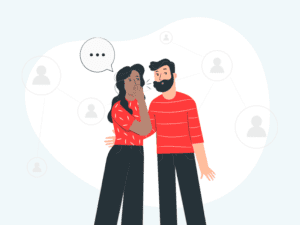Outbound marketing is the collective name for most of the traditional marketing activities we are familiar with from before the rise of the internet.
It can include advertising, whether traditional or digital, as well as cold emailing, cold calling, or even going to events or trade shows. With the rise of inbound marketing, particularly content marketing, outbound tactics have become less popular as they’re seen as intrusive.
However, when done properly—especially for B2B clients—outbound marketing is a fantastic way to let your ideal customers know about your services.
Research your target audience

Before anything, you need to know exactly who you are targeting. The only reason that outbound marketing has the reputation of being annoying is because it’s often carried out without discretion through blanket campaigns.
This is just spamming.
What’s more, at the end of the day, if you take this approach you end up wasting both your time as well as the time of your customers. So, before you begin you need to define both your target audience and your buyer persona.
The target audience is the general group of people that you believe will be interested in your product or service. You’ll be looking at broad criteria such as gender, income, age, and similar markers. Once you have the target audience defined, you can then develop a buyer persona—which helps you delve into the psychology of individuals within the target audience.
The main focus of your research should be on identifying problems that you can solve. After all, the reason you are in business is because you believe you have a solution to make others’ lives easier.
Once you’re clear who you’re targeting, you can begin developing your outreach efforts.
Personalized cold emails
Emails are a cheap and effective marketing tactic that can have a substantial ROI. Again, that doesn’t mean that you just start sending emails to any contact you can get your hands on. That’s a great way to be reported as spam and never actually reach anyone’s inbox.
You have to make sure that your email comes across as trustworthy and authentic. A certain amount of flattery may even help you deliver your message, for example:
“Our clients are high-performing professionals. Given your track record of success, we believe you would be perfect…”
Top tips:
- Know your audience.
- Provide value.
- Get to the point.
- Personalize them and avoid sounding “spammy.”
Pick up the phone

In the same vein as cold emailing, cold calling is another extremely effective tactic that has a bad reputation.
But the fact remains there’s no better way to talk directly with a relevant decision-maker, provided that you are following a good script and you have an accurate idea of your targets. Ideally, cold calling should be used only with very highly qualified leads to boost campaign effectiveness and avoid negative responses.
Build your network
LinkedIn is the holy grail for B2B marketers, with 59% claiming they generate leads on the platform. If you are in B2B, you’re likely to have a lot of decision-making prospects active on the platform.
With LinkedIn, automation is the key as you can easily send professional emails directly to their InMails to build rapport and move them quickly down the funnel. Just be careful to check LinkedIn’s Terms of Service to avoid accidentally violating them.
Get out there on Google
Digital advertising is a great way to spend your marketing budget—and you’re never short of options. Some of the most popular types of ads are:
- Search engine marketing (SEM).
- Display ads
- Social media ads
- Over-the-top (OTT) ads
- Email ads
- Native advertising
- Video ads
The type that you opt for should be based on very specific factors of your target audience. This can range from demographics and geography to their behavioral characteristics, interests, and habits.
With so many options out there, you really can develop a huge array of strategies. But one that we like in particular is to use your outbound marketing strategy to complement your inbound one.
The way you do this is with retargeting and remarketing.
Retargeting campaigns

Retargeting campaigns are simply when you aim your ad at someone who has already visited your website or have otherwise had contact with you and your product.
Pixel-based retargeting
This type of retargeting is aimed at those anonymous phantoms who visited your website. You don’t know their name, number, or email address—the only trace you have of them is the piece of JavaScript known as a pixel that is placed on their browser.
If someone visits your website. If they view a specific page. If they then leave. Then your retargeting campaign will be triggered soon after.
Assuming you’re running a pay-per-click campaign, the target will be shown a relevant ad that they can click on, continuing their way down the funnel.
List-based retargeting
List-based retargeting is when you do have their info stored in your database. If you have a list of email addresses, you can simply upload them to a social network like Facebook or Twitter and the platform will target your ads at the individuals on their platform with the same email address.
This approach isn’t as common and works best if you have highly customized criteria for your ads. For it to work, your contact must also be signed up to the platform you’re targeting. If not, they simply won’t see your ad.
Remarketing vs retargeting
You may also have heard the term “remarketing” and might be wondering what the difference is. Well, the short answer is not too much. The general idea is the same, where you’re targeting people who have had previous contact with your brand.
With retargeting, you are trying to convert new prospects or leads and turn them into customers. Remarketing, however, focuses on those who have already made a purchase with you and the idea is to re-spark interest in your brand.
Think of all those emails you get from companies like Uber or Amazon. If you’ve already used their service before, unprompted emails or messages are likely part of a remarketing campaign.
Use referrals to get new customers

Finally, as part of your outbound content strategy, you can use referrals. This may not be a traditional lead generation tactic, but that’s not to say it isn’t worthwhile. We tend to trust businesses that are recommended to us more than ones that claim their own superiority. This is something we can use!
The referral program you choose may vary depending on your business. For example, if it’s a subscription service of some kind, whether entertainment, SaaS, or anything else, you can offer free upgrades or discounts for anyone who brings in a new customer.
Alternatively, you may offer a commission on new referrals. Whatever way you decide to package it, referrals are something you should leverage.
While inbound marketing has risen in popularity over the last decade, that doesn’t mean there still isn’t a place for its outbound counterpart. When properly executed, an outbound campaign can enhance your inbound efforts, while also adding huge value to your marketing efforts in its own right. With clearly defined targets and goals, outbound marketing is a powerful tool that every business should leverage to boost their sales.
Want to find out more about how you can maximize your sales and marketing efforts? Get in touch now!

